中国饮食文化 英文版
- 格式:ppt
- 大小:7.11 MB
- 文档页数:77
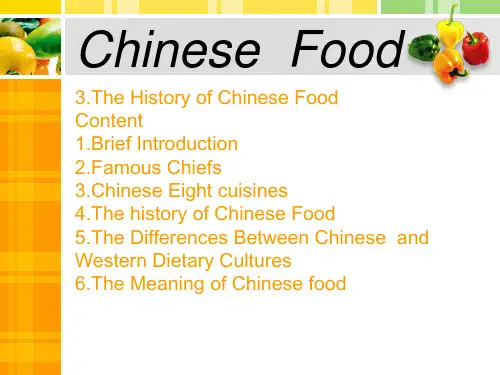
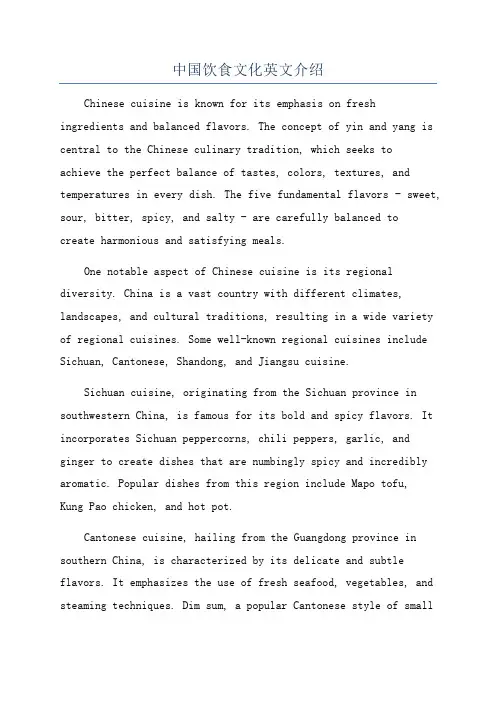
中国饮食文化英文介绍Chinese cuisine is known for its emphasis on freshingredients and balanced flavors. The concept of yin and yang is central to the Chinese culinary tradition, which seeks toachieve the perfect balance of tastes, colors, textures, and temperatures in every dish. The five fundamental flavors - sweet, sour, bitter, spicy, and salty - are carefully balanced tocreate harmonious and satisfying meals.One notable aspect of Chinese cuisine is its regional diversity. China is a vast country with different climates, landscapes, and cultural traditions, resulting in a wide variety of regional cuisines. Some well-known regional cuisines include Sichuan, Cantonese, Shandong, and Jiangsu cuisine.Sichuan cuisine, originating from the Sichuan province in southwestern China, is famous for its bold and spicy flavors. It incorporates Sichuan peppercorns, chili peppers, garlic, and ginger to create dishes that are numbingly spicy and incredibly aromatic. Popular dishes from this region include Mapo tofu,Kung Pao chicken, and hot pot.Cantonese cuisine, hailing from the Guangdong province in southern China, is characterized by its delicate and subtle flavors. It emphasizes the use of fresh seafood, vegetables, and steaming techniques. Dim sum, a popular Cantonese style of smallsavory and sweet dishes, is widely enjoyed throughout China and around the world.Shandong cuisine, originating from the eastern coastal province of Shandong, focuses on bold and hearty flavors. It is known for its use of seafood, especially fish, and the incorporation of strong seasonings like vinegar and soy sauce. Famous dishes from this region include Sweet and Sour Mandarin Fish and Braised Eel.In addition to regional cuisines, Chinese street food is a beloved aspect of Chinese food culture. From savory items like Shanghai-style fried noodles and Beijing-style lamb skewers to sweet treats like bubble tea and sticky rice cakes, street food offers a glimpse into the vibrant and bustling food scene of China.The popularity of Chinese cuisine extends far beyond China's borders. Chinese restaurants can be found in cities around the world, offering a taste of China's culinary heritage to peopleof all backgrounds. Chinese immigrants have also brought their culinary traditions with them, resulting in the fusion of Chinese flavors with local ingredients and cooking styles in countries like the United States and Canada.Chinese cuisine is not only about the food but also about the social and cultural significance it holds. Meals are often shared family-style, where several dishes are served and enjoyedtogether. Food plays a central role in celebrations and festivals, with specific dishes and ingredients symbolizing good luck, prosperity, and health.In conclusion, Chinese cuisine is a fascinating blend of regional traditions, flavors, and techniques. With its focus on balance, freshness, and variety, Chinese food offers adelightful and diverse culinary experience. Whether it's enjoying a bowl of hot and sour soup or savoring a plate of Peking duck, Chinese cuisine never fails to captivate andsatisfy food lovers around the world.。
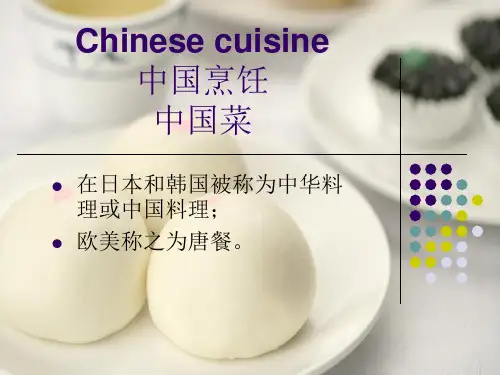
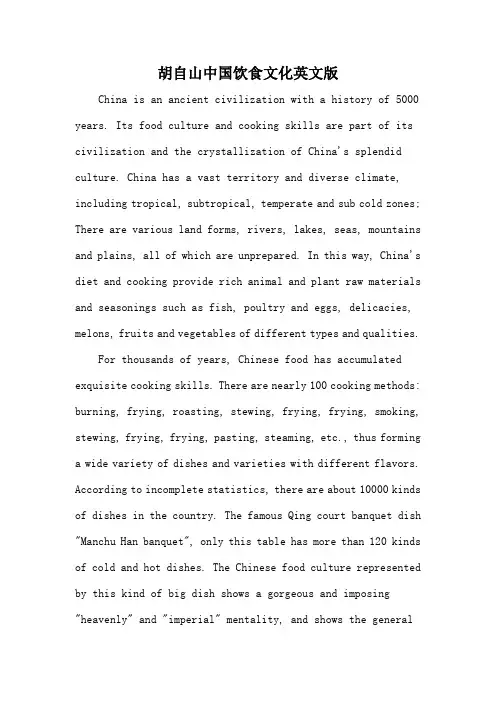
胡自山中国饮食文化英文版China is an ancient civilization with a history of 5000 years. Its food culture and cooking skills are part of its civilization and the crystallization of China's splendid culture. China has a vast territory and diverse climate, including tropical, subtropical, temperate and sub cold zones; There are various land forms, rivers, lakes, seas, mountains and plains, all of which are unprepared. In this way, China's diet and cooking provide rich animal and plant raw materials and seasonings such as fish, poultry and eggs, delicacies, melons, fruits and vegetables of different types and qualities.For thousands of years, Chinese food has accumulated exquisite cooking skills. There are nearly 100 cooking methods: burning, frying, roasting, stewing, frying, frying, smoking, stewing, frying, frying, pasting, steaming, etc., thus forming a wide variety of dishes and varieties with different flavors. According to incomplete statistics, there are about 10000 kinds of dishes in the country. The famous Qing court banquet dish "Manchu Han banquet", only this table has more than 120 kinds of cold and hot dishes. The Chinese food culture represented by this kind of big dish shows a gorgeous and imposing "heavenly" and "imperial" mentality, and shows the generalcharacteristics of Chinese traditional culture.。
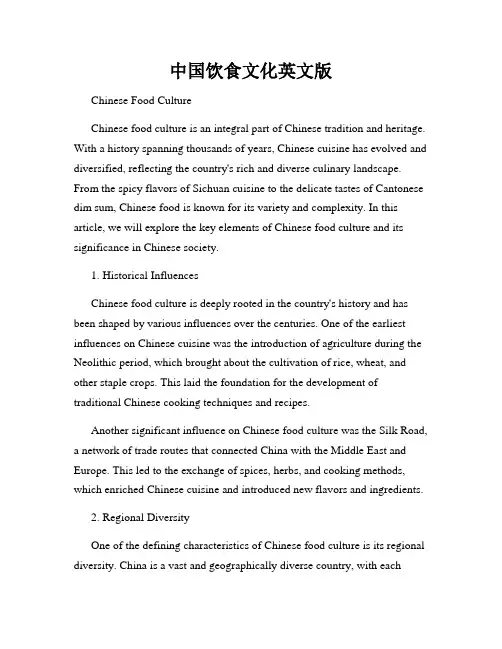
中国饮食文化英文版Chinese Food CultureChinese food culture is an integral part of Chinese tradition and heritage. With a history spanning thousands of years, Chinese cuisine has evolved and diversified, reflecting the country's rich and diverse culinary landscape. From the spicy flavors of Sichuan cuisine to the delicate tastes of Cantonese dim sum, Chinese food is known for its variety and complexity. In this article, we will explore the key elements of Chinese food culture and its significance in Chinese society.1. Historical InfluencesChinese food culture is deeply rooted in the country's history and has been shaped by various influences over the centuries. One of the earliest influences on Chinese cuisine was the introduction of agriculture during the Neolithic period, which brought about the cultivation of rice, wheat, and other staple crops. This laid the foundation for the development of traditional Chinese cooking techniques and recipes.Another significant influence on Chinese food culture was the Silk Road, a network of trade routes that connected China with the Middle East and Europe. This led to the exchange of spices, herbs, and cooking methods, which enriched Chinese cuisine and introduced new flavors and ingredients.2. Regional DiversityOne of the defining characteristics of Chinese food culture is its regional diversity. China is a vast and geographically diverse country, with eachregion having its own unique culinary traditions and specialties. For example, the spicy and numbing flavors of Sichuan cuisine are a stark contrast to the light and fresh flavors of Shandong cuisine.Each region in China has its own distinct ingredients, cooking styles, and flavor profiles, which are influenced by local customs, climate, and geography. This regional diversity has contributed to the richness and depth of Chinese cuisine, making it one of the most diverse and vibrant culinary traditions in the world.3. Social SignificanceIn Chinese culture, food is not just sustenance but also a symbol of social connections and harmony. Shared meals play a central role in Chinese social life, bringing families and communities together to celebrate festivals, weddings, and other important occasions. The act of preparing and sharing food is seen as a way to strengthen bonds and foster relationships.Food also holds symbolic significance in Chinese culture, with certain dishes and ingredients representing prosperity, happiness, and good fortune. For example, fish is often served whole during Lunar New Year celebrations to symbolize abundance and prosperity, while dumplings are eaten to usher in wealth and good luck.4. Traditional PracticesChinese food culture is steeped in tradition, with many customs and practices that have been passed down through generations. One such practice is the concept of "balance" in Chinese cuisine, which emphasizes the harmony of flavors, textures, and colors in a meal. It is believed that a well-balanced meal not only nourishes the body but also balances the body's energy and promotes good health.Another traditional practice in Chinese food culture is the use of food as medicine. Many ingredients in Chinese cuisine, such as ginseng, goji berries, and lotus seeds, are believed to have healing properties and are used in traditional Chinese medicine to treat various ailments.5. Modern TrendsWhile Chinese food culture is steeped in tradition, it has also evolved and adapted to changing tastes and lifestyles. In recent years, there has been a growing interest in healthy eating and sustainable food practices in China, leading to the popularity of organic and locally sourced ingredients.The rise of food delivery services and online platforms has also transformed the way Chinese people eat, making it easier to access a wide range of cuisines from the comfort of their homes. Despite these changes, traditional Chinese food culture continues to thrive, with a renewed interest in preserving and promoting the country's culinary heritage.In conclusion, Chinese food culture is a reflection of the country's rich history, regional diversity, and social values. With its emphasis on balance, harmony, and tradition, Chinese cuisine remains one of the most vibrant and enduring culinary traditions in the world. By exploring the key elements of Chinese food culture, we can gain a deeper appreciation for the role that food plays in Chinese society and its significance in everyday life.。
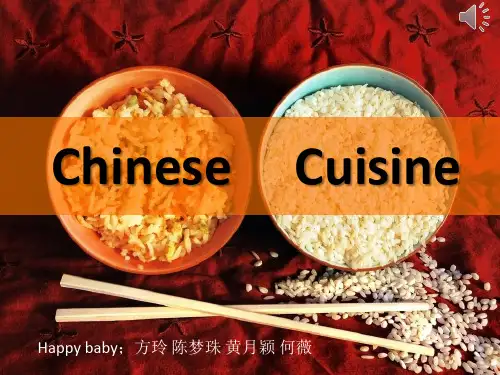
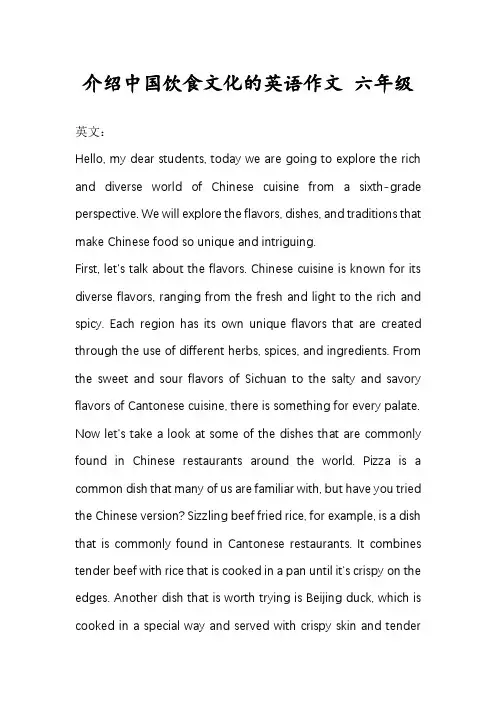
介绍中国饮食文化的英语作文六年级英文:Hello, my dear students, today we are going to explore the rich and diverse world of Chinese cuisine from a sixth-grade perspective. We will explore the flavors, dishes, and traditions that make Chinese food so unique and intriguing.First, let's talk about the flavors. Chinese cuisine is known for its diverse flavors, ranging from the fresh and light to the rich and spicy. Each region has its own unique flavors that are created through the use of different herbs, spices, and ingredients. From the sweet and sour flavors of Sichuan to the salty and savory flavors of Cantonese cuisine, there is something for every palate. Now let's take a look at some of the dishes that are commonly found in Chinese restaurants around the world. Pizza is a common dish that many of us are familiar with, but have you tried the Chinese version? Sizzling beef fried rice, for example, is a dish that is commonly found in Cantonese restaurants. It combines tender beef with rice that is cooked in a pan until it's crispy on the edges. Another dish that is worth trying is Beijing duck, which is cooked in a special way and served with crispy skin and tendermeat.Now let's talk about some of the traditional Chinese dishes that are a part of Chinese New Year celebrations. One such dish is jiaozi, or dumplings. These dumplings are filled with various fillings like pork, shrimp, vegetables, and more. Another dish that is commonly found at Chinese New Year celebrations is mapo tofu, which is a creamy tofu dish with a hint of spice.中文:同学们,大家好!今天我们要从六年级的角度来探讨一下中国的饮食文化。
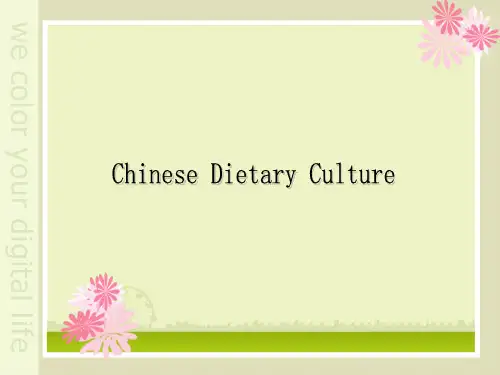
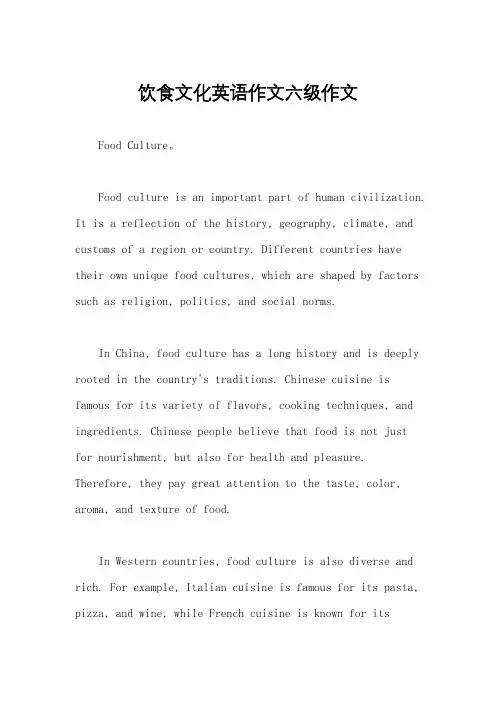
饮食文化英语作文六级作文Food Culture。
Food culture is an important part of human civilization. It is a reflection of the history, geography, climate, and customs of a region or country. Different countries have their own unique food cultures, which are shaped by factors such as religion, politics, and social norms.In China, food culture has a long history and is deeply rooted in the country's traditions. Chinese cuisine is famous for its variety of flavors, cooking techniques, and ingredients. Chinese people believe that food is not justfor nourishment, but also for health and pleasure. Therefore, they pay great attention to the taste, color, aroma, and texture of food.In Western countries, food culture is also diverse and rich. For example, Italian cuisine is famous for its pasta, pizza, and wine, while French cuisine is known for itscheese, wine, and pastries. In the United States, fast food is a popular part of the culture, with hamburgers, fries, and soft drinks being a common meal for many people.Food culture is not only about the food itself, but also about the social customs and rituals surrounding it. In many cultures, food is a way of bringing people together and strengthening relationships. For example, in China, it is common for families to gather around a table and share a meal, while in Japan, the tea ceremony is a formal ritual that involves preparing and serving tea to guests.Food culture is also influenced by globalization and the spread of international cuisine. As people travel and migrate to different parts of the world, they bring their own food traditions with them, and also adopt new foods and cooking styles. This has led to the fusion of different cuisines and the creation of new dishes and flavors.In conclusion, food culture is an important aspect of human civilization that reflects the history, geography, and customs of a region or country. It is a way ofexpressing identity, sharing traditions, and bringing people together. As the world becomes more connected, food culture will continue to evolve and adapt, creating new opportunities for exploration and enjoyment.。
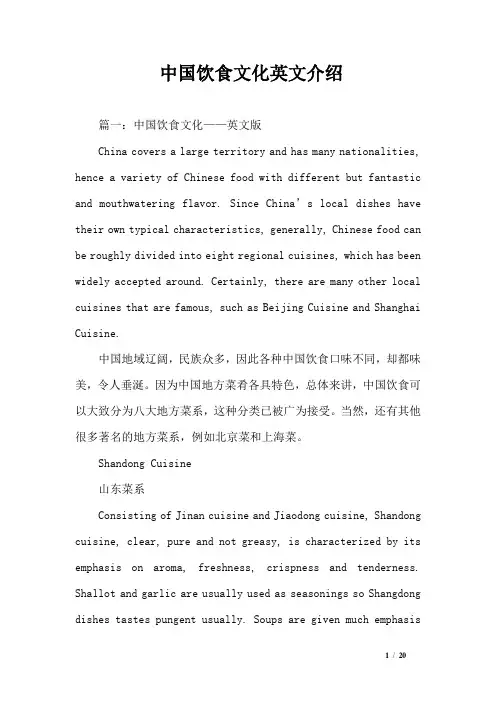
中国饮食文化英文介绍篇一:中国饮食文化——英文版China covers a large territory and has many nationalities, hence a variety of Chinese food with different but fantastic and mouthwatering flavor. Since China’s local dishes have their own typical characteristics, generally, Chinese food can be roughly divided into eight regional cuisines, which has been widely accepted around. Certainly, there are many other local cuisines that are famous, such as Beijing Cuisine and Shanghai Cuisine.中国地域辽阔,民族众多,因此各种中国饮食口味不同,却都味美,令人垂涎。
因为中国地方菜肴各具特色,总体来讲,中国饮食可以大致分为八大地方菜系,这种分类已被广为接受。
当然,还有其他很多著名的地方菜系,例如北京菜和上海菜。
Shandong Cuisine山东菜系Consisting of Jinan cuisine and Jiaodong cuisine, Shandong cuisine, clear, pure and not greasy, is characterized by its emphasis on aroma, freshness, crispness and tenderness. Shallot and garlic are usually used as seasonings so Shangdong dishes tastes pungent usually. Soups are given much emphasisin Shangdong dishes. Thin soup features clear and fresh while creamy soup looks thick and tastes strong. Jinan cuisine is adept at deep-frying, grilling, frying and stir-frying while Jiaodong division is famous for cooking seafood with fresh and light taste.山东菜系,由济南菜系和胶东菜系组成,清淡,不油腻,以其香,鲜,酥,软而闻名。
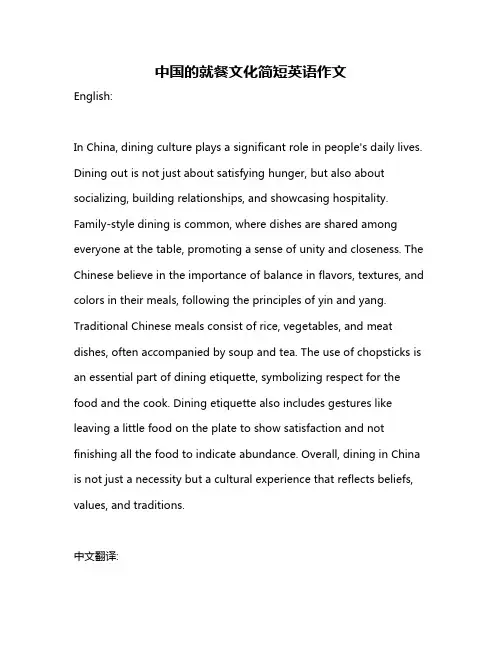
中国的就餐文化简短英语作文English:In China, dining culture plays a significant role in people's daily lives. Dining out is not just about satisfying hunger, but also about socializing, building relationships, and showcasing hospitality. Family-style dining is common, where dishes are shared among everyone at the table, promoting a sense of unity and closeness. The Chinese believe in the importance of balance in flavors, textures, and colors in their meals, following the principles of yin and yang. Traditional Chinese meals consist of rice, vegetables, and meat dishes, often accompanied by soup and tea. The use of chopsticks is an essential part of dining etiquette, symbolizing respect for the food and the cook. Dining etiquette also includes gestures like leaving a little food on the plate to show satisfaction and not finishing all the food to indicate abundance. Overall, dining in China is not just a necessity but a cultural experience that reflects beliefs, values, and traditions.中文翻译:在中国,就餐文化在人们的日常生活中起着重要作用。
中国饮食文化介绍英文版Chinese food culture has a long and rich history dating back thousands of years. It is an integral part of Chinese tradition and plays a significant role in the daily lives of the Chinese people. From the diverse range of ingredients and cooking techniques to the intricate presentation and social significance of meals, Chinese culinary traditions embody the country's vibrant cultural heritage.At the heart of Chinese food culture lies the belief in the harmony between humans and nature. This philosophy is reflected in the emphasis on using fresh, seasonal ingredients and the careful balance of flavors, colors, and textures in each dish. The Chinese culinary approach is often described as a "yin-yang" balance, where contrasting elements such as hot and cold, sweet and sour, or spicy and mild are seamlessly combined to create a dynamic and satisfying dining experience.One of the defining features of Chinese cuisine is its regional diversity. China is a vast and geographically diverse country, and each region has developed its own unique culinary traditionsinfluenced by local climate, geography, and cultural influences. For example, the Cantonese cuisine of the southern Guangdong province is known for its delicate, lightly cooked dishes that highlight the natural flavors of the ingredients. In contrast, the Sichuan cuisine of the southwestern Sichuan province is renowned for its bold, spicy flavors and the use of Sichuan peppercorns, which create a distinctive numbing sensation.Another key aspect of Chinese food culture is the social significance of meals. Sharing food is an integral part of Chinese social rituals and family gatherings. Meals are often served family-style, with multiple dishes placed on the table for everyone to share. This encourages conversation, social interaction, and the appreciation of the diverse flavors and textures of the meal. The act of sharing food is seen as a way to foster relationships, express affection, and create a sense of community.In addition to the social aspect, Chinese cuisine also places great importance on the presentation and aesthetics of the food. The careful arrangement of dishes, the use of colorful garnishes, and the incorporation of symbolic elements, such as the use of auspicious ingredients or the arrangement of dishes to resemble lucky numbers, all contribute to the overall dining experience. The Chinese believe that the appearance of the food should be as pleasing to the eye as the flavors are to the palate.One of the most iconic and well-known aspects of Chinese food culture is the use of chopsticks. Chopsticks have been used in China for thousands of years and are an integral part of the dining experience. They are not only a practical tool for eating but also a symbol of Chinese cultural identity. The art of using chopsticks is deeply ingrained in Chinese culture, and mastering the skill is seen as a sign of cultural refinement and social etiquette.The diversity of Chinese cuisine is also reflected in the wide range of cooking techniques and methods. From the delicate steaming of dim sum to the high-heat wok-frying of stir-fries, Chinese chefs have developed a vast repertoire of cooking techniques that showcase the versatility of their ingredients and the creativity of their culinary traditions. These techniques are often passed down from generation to generation, with each chef putting their own unique spin on traditional recipes.Furthermore, the role of tea in Chinese food culture cannot be overstated. Tea has been an integral part of Chinese society for centuries and is often served alongside meals as a palate cleanser and digestive aid. The ritual of preparing and serving tea is deeply rooted in Chinese cultural practices, with different types of tea being paired with specific dishes to enhance the dining experience.In recent years, Chinese cuisine has gained global recognition and popularity, with Chinese restaurants and dishes becoming increasingly prevalent around the world. However, the essence of Chinese food culture goes beyond just the food itself. It is a rich tapestry of traditions, beliefs, and social customs that are deeply ingrained in the Chinese way of life. As more people discover the wonders of Chinese cuisine, it is essential to appreciate and understand the cultural context and significance that underlie these culinary traditions.In conclusion, the Chinese food culture is a testament to the country's rich history, diverse regional influences, and profound respect for the natural world. From the intricate balance of flavors to the social significance of meals, Chinese cuisine is a celebration of the country's cultural heritage and a window into the heart and soul of the Chinese people. As the world continues to embrace the wonders of Chinese food, it is crucial to recognize and preserve the unique cultural traditions that make it such a beloved and enduring part of the global culinary landscape.。
Chinese Food: The Enchanting Cultureof Chinese CuisineThe Regional Diversity of Chinese CuisineChina's vast territory and diverse ethnic groups have given rise to a multitude of regional cuisines, each with its unique characteristics. From the spicy and bold flavors of Sichuan cuisine to the delicate and subtle tastes of Cantonese cuisine, Chinese food offers a gastronomic journey that is both exciting and enlightening.Sichuan Cuisine: A Spicy DelightCantonese Cuisine: A Symphony of FlavorsCantonese cuisine, also known as Guangdong cuisine, is known for its light and fresh flavors. Dim sum, a Cantonese specialty, is a delightful array of small dishes, including steamed dumplings, savory buns, and delicate pastries. The emphasis on fresh ingredients and precise cooking techniques makes Cantonese cuisine a favorite among food connoisseurs.The Cultural Significance of Chinese CuisineThe Art of Chinese CookingChinese cooking is a blend of art and science, with techniques passed down through generations. The wok, a versatile cooking utensil, is central to Chinese cuisine.Stirfrying, a quick and highheat cooking method, is used to create dishes like Beef and Broccoli and Kung Pao Chicken, ensuring that ingredients remain fresh and vibrant.In conclusion, Chinese cuisine is a treasure trove of flavors, traditions, and stories. By exploring the diverse regional cuisines and understanding the cultural significance behind each dish, one can gain a deeper appreciation for the enchanting culture of Chinese food.The Philosophy Behind Chinese Culinary ArtsThe Importance of Seasonality and FreshnessChinese culinary traditions place a strong emphasis on the use of seasonal ingredients. The belief is that food should be consumed when it is at its peak of freshness and flavor. This respect for nature's rhythm ensures that diners enjoy the best that each season has to offer. From spring's tender bamboo shoots to winter's hearty root vegetables, the changing of the seasons is celebrated on the Chinese dining table.The Role of Tea in Chinese CultureThe Art of Table Manners and EtiquetteThe Future of Chinese CuisineAs Chinese cuisine continues to captivate the world, it is evolving while maintaining its traditional roots. Young chefs are experimenting with fusion styles, blendingtraditional Chinese flavors with international influences.This innovation is breathing new life into classic dishes, making Chinese cuisine more accessible and appealing to a global audience.The Spiritual Connection of Food and FestivalsIn the tapestry of Chinese culture, food plays a pivotal role during festivals and holidays, symbolizing wishes, traditions, and spiritual beliefs. Each festival brings withit a array of special dishes, each carrying its own meaning and significance.The Lunar New Year, or Spring Festival, is perhaps the most celebrated of all. Families gather for a grand feast known as the "Reunion Dinner," where dishes like fish (symbolizing surplus and prosperity), dumplings (shaped like ancient Chinese money and representing wealth), and nian gao (a sweet sticky rice cake signifying growth and progress) are served. These foods are not only delicious but are also eaten with the hope of bringing good fortune for the year ahead.The Art of Presentation and AestheticsChinese cuisine is not only about taste but also about presentation. The arrangement of dishes on a table is an art form in itself, with an emphasis on color, shape, and balance. The goal is to create a visual feast that excites the eyes before the food even touches the lips. This aestheticapproach is evident in the intricate carvings of vegetables and fruits used as garnishes, and in the careful placement of ingredients to form patterns and pictures on the plate.The Legacy of Chinese Culinary TechniquesThe legacy of Chinese cooking techniques is a testament to the ingenuity and resourcefulness of its people. Methods such as red cooking (braising in soy sauce), white cooking (simmering in water or stock), and the delicate art of dim sum making are passed down through generations. These techniques not only enhance the flavors and textures of the ingredients but also preserve the nutritional value of the food, reflecting the Chinese philosophy of health and wellness through diet.The Global Reach of Chinese CuisineIn essence, Chinese cuisine is a living history book, each page filled with stories of tradition, innovation, and the joy of sharing. It is a journey that invites all to partake, a celebration of flavors and cultures that continues to inspire and delight palates worldwide.。
中国饮食文化1. IntroductionChina’s food culture is rich and diverse, and has a history that dates back thousands of years. It is not only about the flavors and tastes, but also the traditions, customs, and symbolism associated with the food. Chinese cuisine is considered one of the most popular and influential cuisines in the world, with a wide range of regional specialties.2. Regional CuisineChina is a vast country with diverse geographic and climatic conditions, which have given rise to a wide variety of regional cuisines. Some of the popular regional cuisines include:2.1 Sichuan CuisineSichuan cuisine is known for its bold flavors, use of spices, and numbing sensation due to the Sichuan peppercorns. Popular dishes include Kung Pao Chicken and Mapo Tofu. Sichuan cuisine is characterized by its mala (numbing and spicy) flavor.2.2 Cantonese CuisineCantonese cuisine is famous for its dim sum, seafood, and delicately prepared dishes. It emphasizes the freshness and natural flavors of the ingredients. Popular dishes include Steamed Dim Sum, Roast Duck, and Sweet and Sour Pork.2.3 Shandong CuisineShandong cuisine is known for its seafood dishes, as the province is located along the coast. It features a combination of flavors, including salty, sweet, and sour. Popular dishes include Braised Abalone and Sweet and Sour Carp.2.4 Hunan CuisineHunan cuisine is characterized by its spicy and savory flavors. It often uses pickled vegetables and chili peppers to create bold and intense tastes. Popular dishes include Spicy Crispy Pork and Stir-Fried Cabbage with Chili.2.5 Jiangsu CuisineJiangsu cuisine is known for its delicate and subtle flavors. It is often associated with the Shanghai style of cooking. Popular dishes include Braised Lion’s Head Meatballs and Beggar’s Chicken.3. Traditional Chinese Food CustomsChinese food customs are deeply rooted in tradition and symbolize various aspects of Chinese culture. Here are some of the common food customs:3.1 Dining EtiquetteChinese dining etiquette emphasizes respect and consideration for others. It is customary to wait for the elders to start eating before others begin. Chopsticks should not be left sticking upright in a bowl, as it is considered impolite.3.2 Lucky FoodsCertain foods are believed to bring good luck and fortune in Chinese culture. For example, fish symbolizes prosperity, and dumplings symbolize wealth and good fortune. These foods are often served during festivals and special occasions.3.3 Festival FoodsChinese festivals are often accompanied by specific food traditions. For example, during the Lunar New Year, a reunion dinner is prepared, which includes dishes with symbolic meanings, such as whole fish for abundance and rice cake for prosperity.4. Modern Chinese CuisineWhile traditional Chinese cuisine remains popular, modern Chinese cuisine has also gained recognition in recent years. Chefs have started experimenting with fusion dishes, incorporating Western ingredients and cooking techniques into Chinese cuisine.5. ConclusionChinese food culture is rich in flavors, traditions, and symbolism. It not only satisfies the taste buds but also reflects the values and beliefs of Chinese society. Whether it is the spicy Sichuan cuisine or the delicate Cantonese dishes, Chinese cuisine continues to captivate people around the world, making it a prominent part of global culinary traditions.Note: This document is written in Markdown format. Markdown is a lightweight markup language that allows for easy formatting and conversion to HTML.。